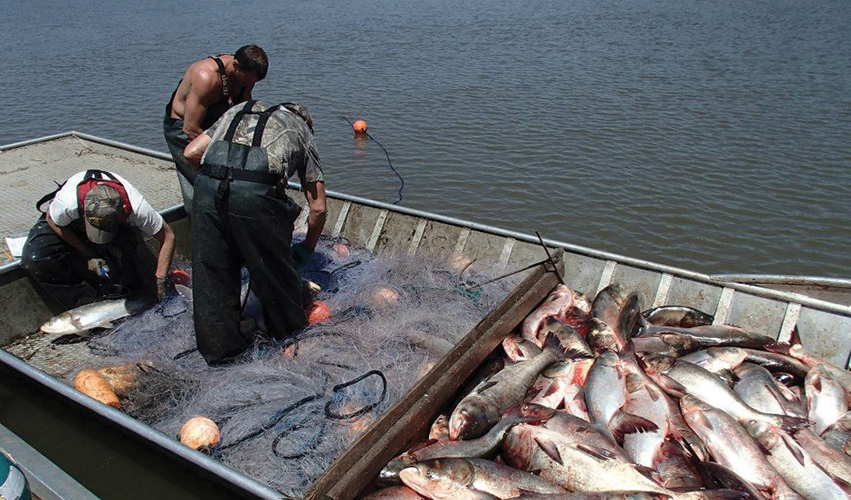
Creating sustained harvest demand to control Asian carp will be complicated.
It’s hard to recall a time when driving a boat on the Illinois River did not mean ducking from flying Asian carp. With that in mind, a research group at Southern Illinois University in Carbondale is collaborating with state and federal government, private industry and other universities to assess how an aggressive harvest could bring the river back to its pleasant, pre-carp days.
A Hard Sell
Getting commercial harvest for Asian carp to take off is not so easy. Asian carp are only remotely related to the much-maligned common carp in the U.S., but the similarity in names—and the fact that Asian carp are not particularly nice to look at—lead to an identity problem. This is not deserved.
Asian carp are revered throughout much of the world as food, and for good reason. Research we conducted in 2010 shows that Asian carp are low in contaminants, high in nutrition and tasty to consumers. They also render high-quality fish meal, an important component of animal feeds, fetching as much as $1,500 per ton. We puzzled as to why hundreds of fishing boats are not lined up to take them away.
Many reasons for a lack of harvest exist. The fishing industry around the Illinois River is not well developed, with few processing plants or distribution centers to get the fish to market or to processors. In addition, Asian carp sell for less than 10 cents per pound, making it nearly impossible for fishermen to make a living off them.
To test whether some extra cash would help, SIU conducted a study in 2011 to determine how incentives such as vouchers for gas and boat maintenance—in exchange for meeting our harvest quotas and providing data—would enhance fishing. This program did not work well, largely because participation by fishermen was poor. So, in 2012, we let the market do the work, putting out an order for three million pounds of Asian carp in the form of fish meal. Within three months, fishermen had removed the targeted mass of Asian carp from the lower 230 miles of the Illinois River. We used the meal for research on animal feed manufacturing and found that Asian carp enhanced the nutrition of aquacultured fishes, including local favorites such as striped “sunshine” bass and rainbow trout.
Driving the Harvest
Harvesting can effectively remove some Asian carp from the river; we just need to stay out of the way and let the existing infrastructure respond to increased demand. One problem is that we created demand through contracted research. To date, no private funding exists to spark the same stimulus. And we learned that fishing may not have exactly our desired impact on the nuisance population. Harvested Asian carp looked different than the population in the river, as fishermen removed the largest and oldest fish, while the most abundant fish in the river are small and young. To be effective at controlling populations, the harvest must target smaller fish, which will require different gears and techniques used by fishermen.
Creating sustained harvest demand to control Asian carp will be complicated. All businesses interested in starting a fishing operation or processing plant ask how many Asian carp are available to be fished. No one wants to build a plant and run out of fish, even if our intent is to control them and take back the river.
We combine regular hydro-acoustic surveys with other sampling to count Asian carp, conservatively estimating that there are about 10 to 15 million pounds of Asian carp produced in the Illinois River annually, only a small fraction of which is fished. Most fish die naturally or move up tributaries, where we cannot track them. About a third of Asian carp in the river come from the Mississippi or Missouri rivers, meaning that as fast as they are harvested or die, they are replaced by others from downstream. For most large companies wanting to turn a profit, 15 million pounds is not enough fish to justify setting up shop. A quick and dirty estimate of the potential annual income of a fish meal operation relying solely on Illinois River Asian carp is about $2 to $3 million.
Targeting Control
But hope for control exists. The river may have more fish production potential than we currently estimate, sparking interest in private investment. Broad multistate and international interest in decreasing the chance that Asian carp will jump upstream barriers and enter Lake Michigan could lead to public-sponsored harvest control efforts, similar to our small-scale study. The risk in the back of the minds of many conservationists is that creating a fishery for Asian carp will cause an economic dependency and pressure to sustain stocks. However, the alternative of inaction—or waiting for some yet unknown technological control agent to come down the line—will prolong the misery of failed fishing trips, squash recreation, and perhaps cause an invasion into the Great Lakes. With research, a balance between public support and private cooperation can be found that works for everyone. iBi
Jim Garvey is Interim Vice Chancellor for Research at Southern Illinois University in Carbondale. He can be reached at jgarvey@siu.edu.

